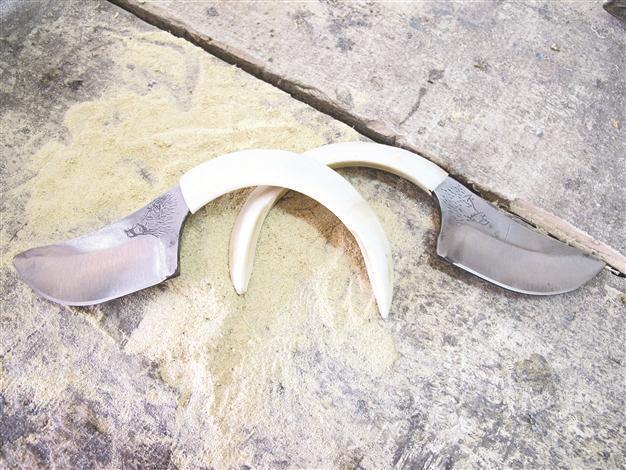Knives like works of art
Wilco van Herpen Hürriyet Daily News

Knifemaker Haluk Yücesan produces knives like works of art in his shop. All of his knives have different designs.
The beauty of Turkey is that you can go to a place several times but every time you visit that place you discover something new. I am not talking about the big places like Istanbul, Ankara, İzmir or Diyarbakır, no; I am talking about smaller cities or even villages.A while ago I was in the Black Sea province of Giresun and while walking around I heard the sound of a hammer banging on iron. Although there were no big pieces of iron in front of the little shop, the sound was definitely one of a blacksmith. I got curious and walked toward the sound of metal on metal.
In the shop a tall man with a firm build and a ponytail and some big tattoos on his arms was indeed hammering a piece of red hot metal. In the window of his workshop there were some knives on display, but they were definitely not the kind of knives that you generally see. These were works of art not particularly made to use in the kitchen but more decorative or hunting knives. Generally I am not very into knives or other weapons but this was different. I could see the craftsmanship of the knives.
Different kinds of designs

I entered the shop and Haluk Yücesan, as I had already read on a sign on the door, looked up from his work. I could not understand if he was disturbed or not by my entering his workshop so I quietly greeted him. Without saying anything he returned to his job, beating the now-cooled metal and then put his hammer aside. Not exactly knowing what to say I complimented him on the beautiful knives I saw in the window display. I looked around his workshop. It was bright, and there were machines, big machines. One for polishing and one for sharpening the knives and a couple of more machines for God knows what. On his workbench some half-finished knives were lying around. What surprised me more were some designs of knives that I saw and a small notebook with all different kinds of designs.
Finally he welcomed me and offered me a cup of tea. We sat down and chatted a bit. It did not take long before Haluk started to open up and he told me the story of how it began. “A couple of years ago I walked down this street and while passing by a knife shop I looked inside. An old man was making knives and suddenly I had the urge to enter the little workshop. While talking to this usta I suddenly knew what I wanted to do. I was going to be a knife maker. It was as if the usta had waited for this moment and he taught me all the tricks and skills you have to know to make good knives. Believe it or not but after the usta taught me all the skills it was as if his life mission had ended. Shortly thereafter he passed away, and I took over the business. With the skills I had learned and some ideas of my own I started working and soon the first new clients came in. It was as if they had waited for me because all of a sudden the requests for specially designed knives started. I generally want to see the person the knife is for, because I think the character of the person has to be reflected in his knife. I also ask the client to make a design, and this is how we come up with a unique design.”
‘Lightning iron’ legend
“I use very good quality iron for all my knives but unfortunately the quality of the iron is not as it used to be. In the past they made knives out of iron from train tracks. This was very hard iron, beautiful to work with and the knives would last forever. Nowadays you have to work really hard to make such knives, but I can’t complain.”
I see a couple of big curled tusks of a wild boar. Attached to them are knife blades. “I have long been thinking what shape I should give those knives and this is what I made of it.” He looks around in his workshop and takes a long piece of iron. “There is this legend about ‘Lightning Iron.’ My master told me this legend. In olden days people had a special technique for hardening iron. During a night that there would be thunderstorms the old masters used to climb to the top of a mountain and find an open place. There they would stick the iron that they were going to use for their knives like flagpoles in the ground. They would put as many as 50 or 100 iron strips in the soil and then leave the place. The rain would start pouring down and then a lightning bolt would strike the iron strips. They would be orange or red from the heat of the lightning and the rain would slowly cool the iron down. That should have been the best iron man could ever make.”
Haluk loves his job; that’s for sure. I see a beautiful knife on the counter and ask if I can buy it. “Actually it is for a client, but I think I am going to make another one for him.” We agree on the price and a happy chef Wilco leaves the shop. I know already what I am going to do with the knife; I will use it for cooking on my television program, and with that thought I turn the corner.
















